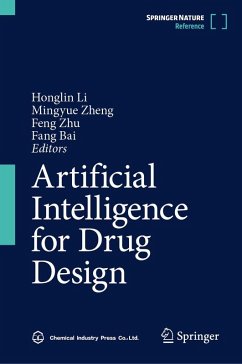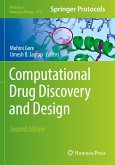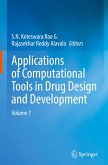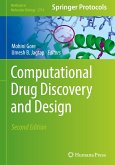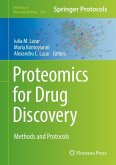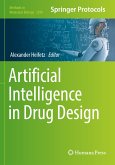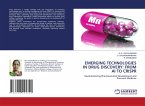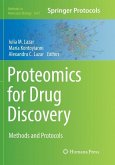Artificial Intelligence for Drug Design
Herausgegeben:Li, Honglin; Zheng, Mingyue; Zhu, Feng; Bai, Fang
Artificial Intelligence for Drug Design
Herausgegeben:Li, Honglin; Zheng, Mingyue; Zhu, Feng; Bai, Fang
- Gebundenes Buch
- Merkliste
- Auf die Merkliste
- Bewerten Bewerten
- Teilen
- Produkt teilen
- Produkterinnerung
- Produkterinnerung
The use of artificial intelligence in drug research and development plays an increasingly important role in evaluating the interaction between biological targets and drug molecules, optimizing drug design paths, etc., helping to accelerate the process of drug research and development and reduce the cost of research and development risks.
This book is aimed at researchers or technicians who are interested in cross-research in the field of life sciences and drug research and development. The content is mainly divided into four parts: 1. Fundamentals of artificial intelligence algorithms; 2.…mehr
Andere Kunden interessierten sich auch für
![Computational Drug Discovery and Design Computational Drug Discovery and Design]() Computational Drug Discovery and Design91,99 €
Computational Drug Discovery and Design91,99 €![Applications of Computational Tools in Drug Design and Development Applications of Computational Tools in Drug Design and Development]() Applications of Computational Tools in Drug Design and Development115,99 €
Applications of Computational Tools in Drug Design and Development115,99 €![Computational Drug Discovery and Design Computational Drug Discovery and Design]() Computational Drug Discovery and Design121,99 €
Computational Drug Discovery and Design121,99 €![Proteomics for Drug Discovery Proteomics for Drug Discovery]() Proteomics for Drug Discovery113,99 €
Proteomics for Drug Discovery113,99 €![Artificial Intelligence in Drug Design Artificial Intelligence in Drug Design]() Artificial Intelligence in Drug Design121,99 €
Artificial Intelligence in Drug Design121,99 €![EMERGING TECHNOLOGIES IN DRUG DISCOVERY: FROM AI TO CRISPR EMERGING TECHNOLOGIES IN DRUG DISCOVERY: FROM AI TO CRISPR]() M. K. VIJAYALAKSHMIEMERGING TECHNOLOGIES IN DRUG DISCOVERY: FROM AI TO CRISPR29,99 €
M. K. VIJAYALAKSHMIEMERGING TECHNOLOGIES IN DRUG DISCOVERY: FROM AI TO CRISPR29,99 €![Proteomics for Drug Discovery Proteomics for Drug Discovery]() Proteomics for Drug Discovery113,99 €
Proteomics for Drug Discovery113,99 €-
-
-
The use of artificial intelligence in drug research and development plays an increasingly important role in evaluating the interaction between biological targets and drug molecules, optimizing drug design paths, etc., helping to accelerate the process of drug research and development and reduce the cost of research and development risks.
This book is aimed at researchers or technicians who are interested in cross-research in the field of life sciences and drug research and development. The content is mainly divided into four parts: 1. Fundamentals of artificial intelligence algorithms; 2. Data foundation and representation; 3. Artificial intelligence and drug design; 4. Program code. It systematically introduces artificial intelligence algorithms, focuses on key data resources in biomedicine, especially some data mining methods based on artificial intelligence. With the drug research and development process as the main line, for each key step where the artificial intelligence algorithm is integrated, it first introduces the basic principles and existing challenges of drug design, and then systematically reviews the progress of artificial intelligence (AI) algorithms in this research direction. Introduce existing cross-application examples.
This book is aimed at researchers or technicians who are interested in cross-research in the field of life sciences and drug research and development. The content is mainly divided into four parts: 1. Fundamentals of artificial intelligence algorithms; 2. Data foundation and representation; 3. Artificial intelligence and drug design; 4. Program code. It systematically introduces artificial intelligence algorithms, focuses on key data resources in biomedicine, especially some data mining methods based on artificial intelligence. With the drug research and development process as the main line, for each key step where the artificial intelligence algorithm is integrated, it first introduces the basic principles and existing challenges of drug design, and then systematically reviews the progress of artificial intelligence (AI) algorithms in this research direction. Introduce existing cross-application examples.
Produktdetails
- Produktdetails
- Verlag: Chemical Industry Press / Springer / Springer Nature Singapore / Springer, Berlin
- Artikelnr. des Verlages: 89501057, 978-981-95-2524-9
- Seitenzahl: 917
- Erscheinungstermin: 16. Januar 2026
- Englisch
- Abmessung: 235mm x 155mm
- ISBN-13: 9789819525249
- ISBN-10: 9819525241
- Artikelnr.: 75207086
- Herstellerkennzeichnung
- Libri GmbH
- Europaallee 1
- 36244 Bad Hersfeld
- gpsr@libri.de
- Verlag: Chemical Industry Press / Springer / Springer Nature Singapore / Springer, Berlin
- Artikelnr. des Verlages: 89501057, 978-981-95-2524-9
- Seitenzahl: 917
- Erscheinungstermin: 16. Januar 2026
- Englisch
- Abmessung: 235mm x 155mm
- ISBN-13: 9789819525249
- ISBN-10: 9819525241
- Artikelnr.: 75207086
- Herstellerkennzeichnung
- Libri GmbH
- Europaallee 1
- 36244 Bad Hersfeld
- gpsr@libri.de
Honglin Li, from Innovation Center for AI and Drug Discovery, East China Normal University. Dr. Honglin Li has dedicated significant time to addressing challenging, cutting-edge scientific problems in drug design and target discovery. He has developed more than ten drug design methods and software primarily focusing on methodological development and applied them to discover new targets and design promising compounds. The representative drug design methods and software suites include the graphical drug design software eSHAFTS and ePharmer, pioneered in China. Target discovery methods like PharmMapper and ChemMapper are popular, boasting a global user base of over 35,000. He has also developed several AI-based drug design methods, such as disease-target knowledge graph e-TSN, near-drug space exploration method CIRS, macrocyclic drug design method MacFormer, and online drug design platform iDrug. He has published over 210 papers in prestigious journals such as Nat. Commun., NAR, Adv. Sci., PNAS, STTT, Engineering, JMC, and other professional publications, accumulating more than 8,000 citations; filed applications for more than 118 invention patents (including 54 domestic authorizations and 13 foreign authorizations) and 15 software copyrights. He has transferred six drug candidates to pharmaceutical companies for pre-clinical research, and three of these drugs progressed to clinical trials. Mingyue Zheng, from Shanghai Institute of Materia Medica, Chinese Academy of Sciences. Dr. Mingyue Zheng received his Ph.D. degree from Shanghai Institute of Materia Medica (SIMM), Chinese Acadamy of Sciences in 2006, majoring in computational drug design. He currently works as a Professor in State Key Laboratory of Drug Research at SIMM, where he focuses on artificial intelligence approaches for rational drug design and discovery. His research interests also encompass multidisciplinary studies in the fields of medicinal chemistry, cheminformatics, and computational biology. He has been engaged in the machine-learning based methodology development around the discovery and structural optimization of lead compounds, the assessment of drug ADME/T properties, as well as the application of the methods in practical drug design and discovery process. Till now, he has published more than 200 papers in Nat Comput Sci, Immunity, Nat Commun, Trends Pharmacol Sci, Circ Res, Protein & Cell, Nucleic Acids Res, etc.
Part 1 Foundations of Machine Learning .- Chapter 1 Supervised Learning.- Chapter 2 Unsupervised Learning.- Chapter 3 Reinforcement Learning.- Chapter 4 Model Evaluation and Validation.- Chapter 5 Application Examples and Code.- Part 2 Fundamentals of Deep Network Architecture Design.- Chapter 6 Convolutional Neural Networks.- Chapter 7 Recurrent Neural Networks.- Chapter 8 Transformer.- Chapter 9 Graph Neural Networks.- Part 3 Deep Generative Models.- Chapter 10 Variational Self-Encoders.- Chapter 11 Generative Adversarial Networks 084.- Chapter 12 Stream Generative Models 088.- Part 4 Deep Reinforcement Learning.- Chapter 13 Value Function-Based Algorithms.- Chapter 14 Policy Gradient Algorithms.- Chapter 15 CartPole Programming Examples.- Part 5 Natural Language Processing, Knowledge Graphs, and Interpretable Artificial Intelligence.- Chapter 16 Natural Language Processing and Text Mining.- Chapter 17 Knowledge Mapping.- Chapter 18 Interpretable Artificial Intelligence.- Part 6 Molecular Structure and Bioactivity Data.- Chapter 19 Biomolecule Structure Database.- Chapter 20 Small Molecule Structure Databases.- Chapter 21 Bioactive Databases.- Part 7 Molecular Data Representation.- Chapter 22 Characterization of Small Molecule Compounds.- Chapter 23 Protein Characterization.- Chapter 24 Characterization of Nucleic Acid Sequences.- Part 8 Drug Target Discovery and Identification.- Chapter 25 Biomics Analysis and Drug Target Discovery and Drug Repositioning.- Chapter 26 Sequence-Based Discovery of Druggable Targets of Proteins.- Chapter 27 Structure- and Network-Based Drugable Target Identification.- Chapter 28 Network Pharmacology and Drug Redirection.- Part 9 Molecular Structure Prediction.- Chapter 29 Protein Structure Prediction.- Chapter 30 Nucleic Acid Structure Prediction.- Chapter 31 Conformational Prediction of Small Molecules.- Part 10 The Developments in Quantum Chemistry and Molecular Force Fields.- Chapter 32 Artificial Intelligence for Computational Chemistry.- Chapter 33 Development and Optimization of Molecular Force Fields.- Part 11 Small Molecule Drug Synthesis and De Novo Design .- Chapter 34 Fragment-Based Drug Design.- Chapter 35 Molecular Generative Modeling.- Chapter 36 Three-Dimensional Molecular Generation.- Chapter 37 Inverse Synthesis Prediction.- Chapter 38 Reaction Performance Prediction and Reaction Condition Optimization.- Part 12 Small Molecule Drug Design and Optimization.- Chapter 39 Small Molecule-Target Binding Affinity Prediction and Scoring Function Design.- Chapter 40 Molecular Docking and Virtual Screening Methods Incorporating Artificial Intelligence.- Chapter 41 Ligand-Based Virtual Screening.- Part 13 AI-Based Design of Macromolecular Drugs.- Chapter 42 Macrocyclic Drug Design.- Chapter 43 Protein and Peptide Macromolecular Drug Design.- Chapter 44 Nucleic Acid Macromolecular Drug Design.- Part 14 ADMET Property Prediction.- Chapter 45 Artificial Intelligence-Based ADMET Prediction.- Chapter 46 Drug Toxicity Prediction.- Chapter 47 Drug Metabolite Prediction.- Part 15 Drug Crystal Form Prediction and Formulation Design.- Chapter 48 Drug Crystal Form Prediction.- Chapter 49 Drug Dosage Form Design.
Part 1 Foundations of Machine Learning .- Chapter 1 Supervised Learning.- Chapter 2 Unsupervised Learning.- Chapter 3 Reinforcement Learning.- Chapter 4 Model Evaluation and Validation.- Chapter 5 Application Examples and Code.- Part 2 Fundamentals of Deep Network Architecture Design.- Chapter 6 Convolutional Neural Networks.- Chapter 7 Recurrent Neural Networks.- Chapter 8 Transformer.- Chapter 9 Graph Neural Networks.- Part 3 Deep Generative Models.- Chapter 10 Variational Self-Encoders.- Chapter 11 Generative Adversarial Networks 084.- Chapter 12 Stream Generative Models 088.- Part 4 Deep Reinforcement Learning.- Chapter 13 Value Function-Based Algorithms.- Chapter 14 Policy Gradient Algorithms.- Chapter 15 CartPole Programming Examples.- Part 5 Natural Language Processing, Knowledge Graphs, and Interpretable Artificial Intelligence.- Chapter 16 Natural Language Processing and Text Mining.- Chapter 17 Knowledge Mapping.- Chapter 18 Interpretable Artificial Intelligence.- Part 6 Molecular Structure and Bioactivity Data.- Chapter 19 Biomolecule Structure Database.- Chapter 20 Small Molecule Structure Databases.- Chapter 21 Bioactive Databases.- Part 7 Molecular Data Representation.- Chapter 22 Characterization of Small Molecule Compounds.- Chapter 23 Protein Characterization.- Chapter 24 Characterization of Nucleic Acid Sequences.- Part 8 Drug Target Discovery and Identification.- Chapter 25 Biomics Analysis and Drug Target Discovery and Drug Repositioning.- Chapter 26 Sequence-Based Discovery of Druggable Targets of Proteins.- Chapter 27 Structure- and Network-Based Drugable Target Identification.- Chapter 28 Network Pharmacology and Drug Redirection.- Part 9 Molecular Structure Prediction.- Chapter 29 Protein Structure Prediction.- Chapter 30 Nucleic Acid Structure Prediction.- Chapter 31 Conformational Prediction of Small Molecules.- Part 10 The Developments in Quantum Chemistry and Molecular Force Fields.- Chapter 32 Artificial Intelligence for Computational Chemistry.- Chapter 33 Development and Optimization of Molecular Force Fields.- Part 11 Small Molecule Drug Synthesis and De Novo Design .- Chapter 34 Fragment-Based Drug Design.- Chapter 35 Molecular Generative Modeling.- Chapter 36 Three-Dimensional Molecular Generation.- Chapter 37 Inverse Synthesis Prediction.- Chapter 38 Reaction Performance Prediction and Reaction Condition Optimization.- Part 12 Small Molecule Drug Design and Optimization.- Chapter 39 Small Molecule-Target Binding Affinity Prediction and Scoring Function Design.- Chapter 40 Molecular Docking and Virtual Screening Methods Incorporating Artificial Intelligence.- Chapter 41 Ligand-Based Virtual Screening.- Part 13 AI-Based Design of Macromolecular Drugs.- Chapter 42 Macrocyclic Drug Design.- Chapter 43 Protein and Peptide Macromolecular Drug Design.- Chapter 44 Nucleic Acid Macromolecular Drug Design.- Part 14 ADMET Property Prediction.- Chapter 45 Artificial Intelligence-Based ADMET Prediction.- Chapter 46 Drug Toxicity Prediction.- Chapter 47 Drug Metabolite Prediction.- Part 15 Drug Crystal Form Prediction and Formulation Design.- Chapter 48 Drug Crystal Form Prediction.- Chapter 49 Drug Dosage Form Design.

